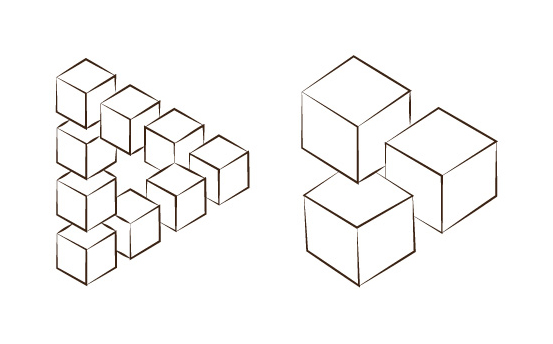I follow a few different artists on Behance, including Yuko Shimizu.
I wrote about Shimizu a while back but as a quick recap, she was born in Japan and worked 11 years doing corporate PR in Tokyo until burning out (her only office job before switching to art), at which point she moved to NYC where she had lived briefly in her childhood. Once in NYC, Shimizu got an art degree, and is now an award-winning illustrator & teacher. Not bad, right?
Anyhow, back to Behance, I see that Shimizu has a new project up, illustrations for The Beautiful and the Grotesque by Ryūnosuke Akutagawa. Akutagawa is a big deal in Japan but is best known in the West as the author of Rashōmon, which inspired the Akira Kurosawa film of the same name. For fans of the author, “The Beautiful and the Grotesque” was originally published as “Exotic Japanese Stories”.
Shimizu has illustrated the cover as well as numerous exquisite black and white illustrations throughout this collection of short stories. My personal favourite is this illustration for “The Kappa”.

Kappa are an interesting part of Japanese folklore. They are water spirits, varyingly portrayed as monsters or tricksters, but also worshipped as benevolent Shinto deities to ensure sufficient water for crops. Is it wrong that they remind me of the Teenage Mutant Ninja Turtles? Or, more to the point, that the TMNT remind me of them. Most westerners are only familiar with Kappa in the context of kappa rolls (kappamaki), so named as a traditional offering to prevent Kappa from abducting children is to throw cucumbers in a nearby lake.
Here are a couple more of the story illustrations – “Saigō Takamori” on the left, and “The Badger” on the right.

Amazing work as always. The entire Behance project can be seen here, and more of Shimizu’s work can be seen on her personal site, yukoart.com.
Optical illusions are an interesting cognitive stumble that can be explained through gestalt theory – but a simple shorthand is to say that what we are seeing doesn’t match up with what we expect to see, and the illusion is the result of our brains try to “fix” the image.
There is a subset of optical illusions known as impossible objects, which I have been really drawn to lately. There is something simply delightful about a good paradox. This, for example, is a blivet, also known as a poiuyt, “the devil’s pitchfork” or “the devil’s tuning-fork”.
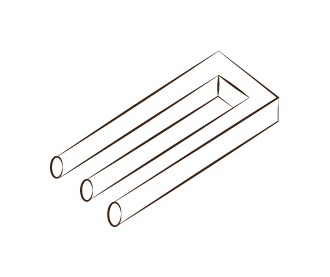
An impossible object (also known as an impossible figure or an undecidable figure) is a type of optical illusion consisting of a two-dimensional figure which is instantly and subconsciously interpreted by the visual system as representing a projection of a three-dimensional object although it is not geometrically possible for such an object to exist (at least not in the form interpreted by the visual system).
– wikipedia
Oscar Reutersvärd was a Swedish artist who invented a whole stack of these kinds of objects. He’s kind of a big deal but has sadly been overshadowed to some degree. Check out these triangle forms he drew using a series of cubes:
He was drawing these kinds of forms well before Lionel and Roger Penrose published their paper in the British Journal of Psychology, but these kinds of forms are generally known as a Penrose square and a Penrose triangle, respectively.
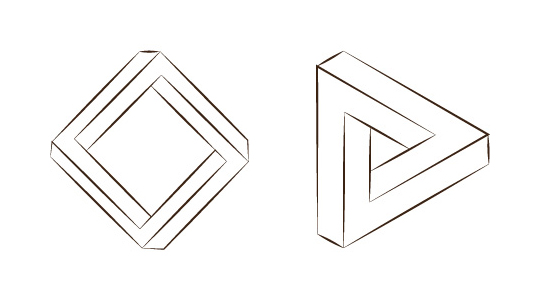
These kinds of objects have inspired many artists, most notably the Dutch artist, M.C. Escher. In this piece, Escher employs what is known as Penrose stairs.
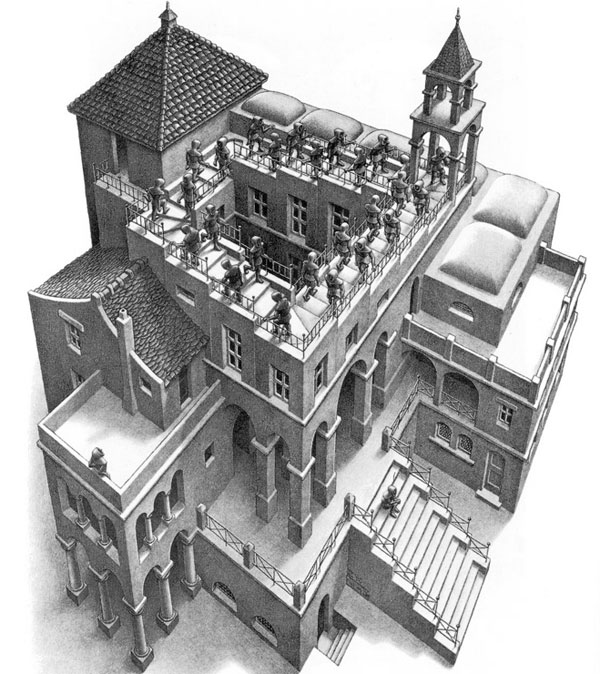
M.C. Escher – Ascending and Descending
…but back to the blivet. It is interesting not only as an impossible object, but also etymologically. Its origin is military, and was coined in WW2. A blivet was originally defined as “ten pounds of shit in a five pound bag”.
A rather colourful description, no?
Who says art always has to be serious?
I was perusing Illustration Age and encountered the so-sweet-it-makes-my-teeth-hurt work of the Malysian illustrator Lim Heng Swee, aka ilovedoodle. You like cute? Yeah, here’s cute in spades.
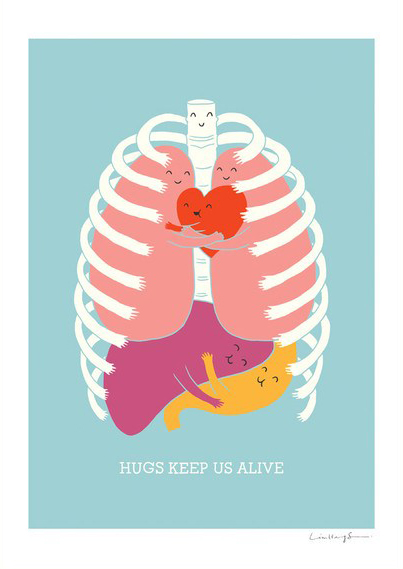
I would describe my work as simple and fun, but with a strong idea or message behind it. Life should be fun and humorous when possible and I hope that my illustrations generate a sense of joy and happiness. I would like to think that they inspire people in their everyday lives.
– Lim Heng Swee
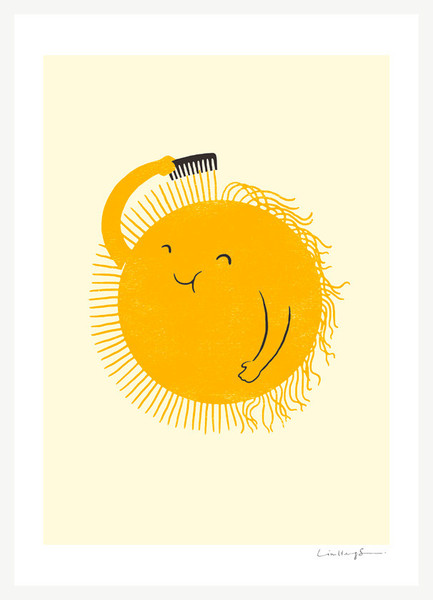
ilovedoodle – bad hair day
There is a strong element of kawaii at play here, but I really enjoy these pieces for a lot of different reasons. Cute appeal aside, ilovedoodle’s work is rich with great visual metaphors that often communicate quite complex ideas with a refreshing playfulness. His bold graphic style brings a lot of visual immediacy, but with a very personal touch that avoids the in-your-face quality that strong graphic approaches sometimes evoke.
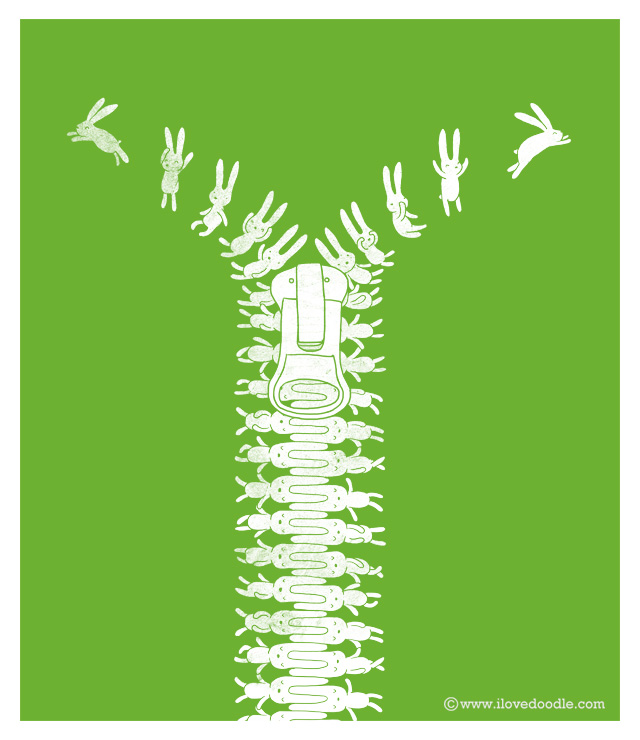
ilovedoodle – zip
In any case, you should check out ilovedoodle.com as there is a lot of really great work there and quite a bit of it is even for sale as prints. Just the thing to brighten up your living space.
FAILE is an artist collective operating out of Brooklyn, and are one of my favourite voices in street art. They’ve been around for a little more than a decade, and started out as a street art crew but have been exhibiting in posh gallery settings as of late and have been playing with the boundaries of low and high art for some time with clever twists not only in subject matter, but also surface and medium. Originally founded by Patrick McNeil, Patrick Miller & Aiko Nakagawa (aka Lady Aiko), since 2006 McNeil and Miller have been pushing FAILE in new directions.
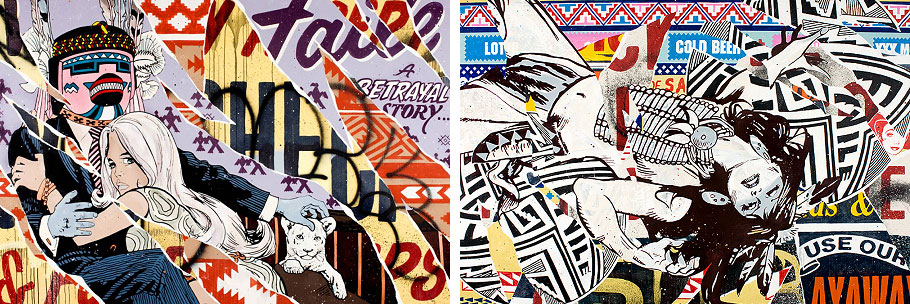
Back in 2008 FAILE put on a show in London,England with Lazarides Gallery, Lost in Glimmering Shadows.

FAILE Eat With the Wolf print – from “Lost in Glimmering Shadows”
Faile’s work takes the visual vocabulary of popular culture, urban decay and consumer excess, and reworks them into new, exciting and sometimes troubling narratives for the viewer. Layers of posters torn away from walls or comic book-inspired remixes, Faile’s instantly recognizable practice refers to a visual culture that is sometimes disposable, yet demands serious attention. Lost in Glimmering Shadows features a new series of paintings and sculptures which explore an ambivalent attitude to the hypermodern culture of today’s USA. As well as incorporating images and texts from the chaos of the modern urban landscape, the works use imagery, stories and patterns from Native American Indian culture. A metaphor of sorts emerges in this juxtaposition; the expanse of contemporary commercialism at the expense of society’s connection with nature and spirit.
– Lost in Glimmering Shadows Press Release (link to pdf)
This year, FAILE has taken the imagery from Lost in Glimmering Shadows into a whole new realm by bringing their imagery to Mongolia.
Patrick Miller: We made this sculpture, which is of an image we did in 2009 called “Eat With the Wolf” and it’s sort of this businessman tearing away a suit, wearing a wolf pelt. He’s placed in their national park, Ulan Bator. Behind the sculpture is this mountain preserve and then he’s looking on to all this new development. So this will all be a grassline, 1600 acre park. It’s wild to have a permanent sculpture in this city.
It’s pretty amazing. It really couldn’t have been a better sort of symbolic thing of what’s happening in Mongolia right now. Basically, they’ve come across all these minerals in mining, copper and gold, and the Russians and the Chinese are descending upon Mongolia to really try and mine the shit out of it. It’s sort like, what’s gonna happen to the city and how will the people actually benefit this? Or will the country just be mined for its resources and kind of left as a shell? So there are a lot of these issues going on there right now, which made this sculpture feel pretty timely.
This image came out of a series we did called “Lost in Glimmering Shadows” and it was sort of imagining if Native Americans had come back to the city today and retaken the land. This image was really about this crisis within of battling between greed and a connection to nature. So we’d been working on this sculpture for awhile on its own with Charlie Becker, who’s a sculptor we work with a lot, and Tiger Translate and the Mongolian Arts Council approached us and asked if we’d be interested in doing a sculpture out there which essentially led to doing that.
-interview with FAILE, Caroline Caldwell viaVandalog

FAILE – the Wolf Within (2012 Ulan Bator)
FAILE got up to some collaborative work with local artists while there, too, which you can read more about in the Vandalog article. It’s all pretty impressive. You can see this and much, much more of FAILE on their website.
I was checking out the Juxtapoz website (as I often do) and they had a feature on a pretty cool artist named Kevin Peterson who, judging by the thumbnails, took photos of people in front of graffiti in urban settings. Uh, scratch that. Paintings of people in front of graffiti in urban settings. Uh, wow.
I do enjoy people making paintings about painting as well as the amusingly meta aspect of making representational realist art based on graffiti – but beyond the mental gymnastics, Peterson can really paint.
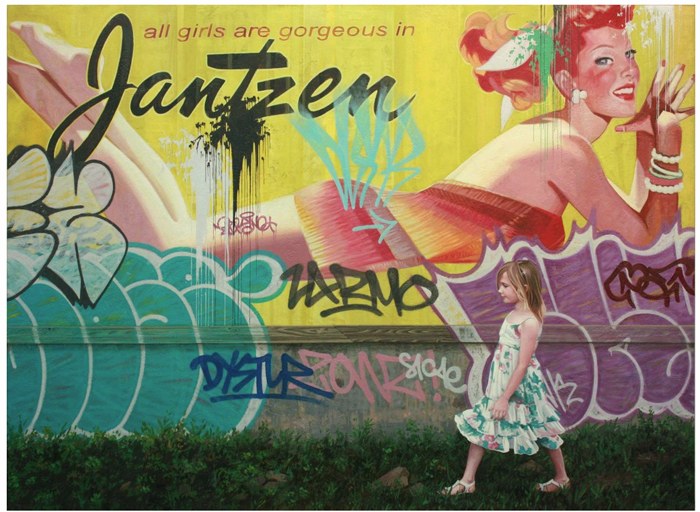
image via Juxtapoz
Houston, Texas-based painter Kevin Peterson has become quite popular in the art world in recent years, especially because his photorealistically rendered portraits have both youthful and urban art elements that suck you into their location. Peterson is set to open Amend, a solo exhibition at Thinkspace Gallery in Culver City this Saturday, November 3, 2012. (view a previous body of work from Kevin here)
Here’s a couple of shots from the Juxtapoz article of Peterson working in his studio so you can see his working method. Straight-up painting is what that is.
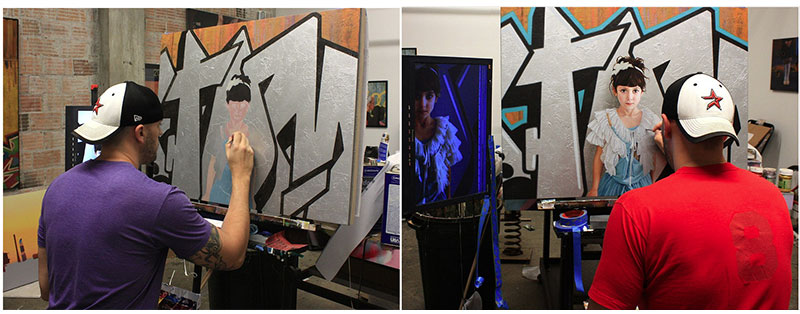
Kevin Peterson – WIP – studio – images via Juxtapoz
If you check out Peterson’s site, you can see that his work keeps getting better and better. He’s exploring some different directions, but it’s these portraits that appeal to me personally the most. There is something playful in how meticulous and process-oriented the reproduction of the graffiti and run-down urban surfaces is, and the juxtaposition of the innocent, happy subject in these grim settings is provocative, but upbeat.
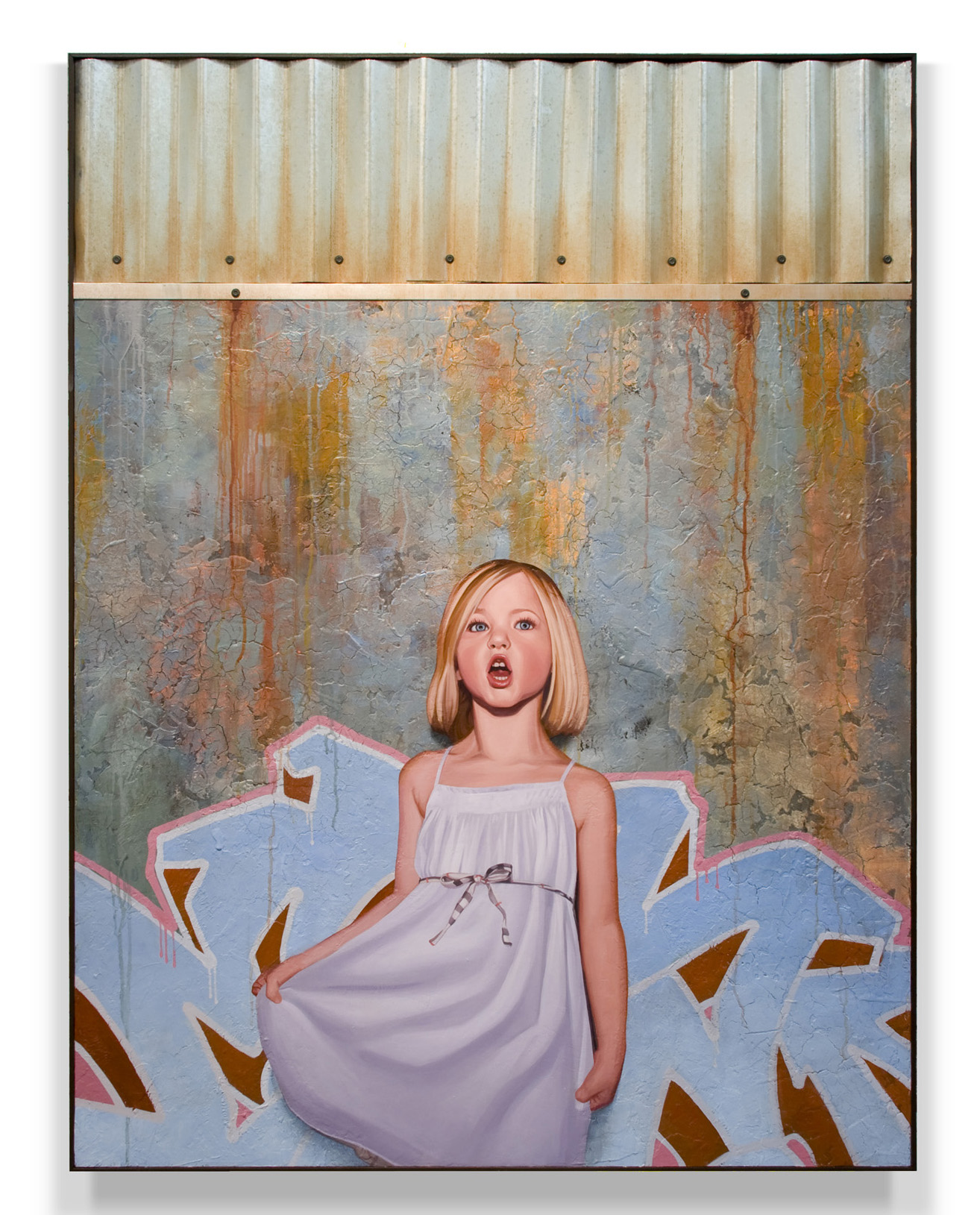
©Kevin Peterson – Old Wall – via kevinpetersonstudios.com
Here’s what Peterson himself has to say about all this:
My work is about the varied journeys we take through life. It’s about growing up and living in a world that is broken. These paintings are about trauma, fear and loneliness and the strength that it takes to survive and thrive. They each contain the contrast of the untainted, young and innocent against a backdrop of a worn, ragged, and defiled world. Support versus restraint, bondage versus freedom, and tension versus slack are all themes that I often visit. My work deals with isolation, loneliness and longing teamed with a level of optimistic hope. Issues of race and the division of wealth have arisen in my recent work. This work deals with the idea of rigid boundaries, the hopeful breakdown of such restrictions, as well as questions about the forces that orchestrate our behavior.
Artist’s statement
So yeah, Kevin Peterson. Definitely a new favourite!


